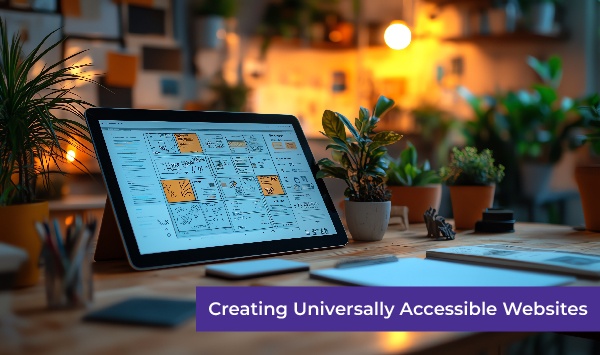In the current digital era, accessibility is becoming a must for websites rather than an optional feature. Over 1 billion individuals worldwide have a disability of some kind, and many of them encounter major obstacles while using the internet. As developers, we have the ability to design inclusive and functioning websites that allow users of all skills and restrictions to access and engage with online information.
It takes deliberate design choices, teamwork, and a dedication to inclusion to create websites that are globally accessible. However, how can developers make sure that every user can access their websites? Let’s examine the greatest techniques and approaches that may be used to create universally accessible digital experiences.
How Developer can Create an Accessible Site?
1. Understanding Web Accessibility
Before diving into the technical aspects, it’s crucial to understand what web accessibility is. Web accessibility refers to designing and developing websites in ways that allow people with disabilities to access, navigate, and interact with them. Disabilities can include visual, auditory, motor, or cognitive impairments.
Accessible websites ensure that all users, including those using assistive technologies like screen readers or voice control software, can access content and functionality.
Web accessibility is not only a matter of social responsibility but also a legal requirement in many countries. For example, the Americans with Disabilities Act (ADA) in the U.S. mandates that websites be accessible to individuals with disabilities. Non-compliance can lead to legal actions and loss of reputation.
2. Follow WCAG Guidelines
The Web Content Accessibility Guidelines (WCAG), developed by the W3C Web Accessibility Initiative (WAI), provide a comprehensive set of guidelines to help make the web accessible to people with various disabilities. These guidelines are organized under four principles:
- Perceivable: Ensure that all information is available to users in ways they can perceive (e.g., providing text alternatives for images and videos).
- Operable: Make sure all interface elements can be used with different input devices (e.g., keyboard, mouse, or touch).
- Understandable: Content should be clear and easy to comprehend, with instructions and error messages that are easy to follow.
- Robust: Design websites that work with current and future technologies, ensuring long-term accessibility.
By adhering to WCAG guidelines, you’ll be following best practices to ensure your website is accessible to a wide range of users.
3. Designing for Accessibility: Key Practices for Developers
a. Semantic HTML
Using semantic HTML ensures that your content is structured in a meaningful way that is easily understood by both users and assistive technologies. Tags like <header>, <footer>, <nav>, and <article> help define the different sections of your page and make it easier for screen readers to interpret content.
Using proper heading tags (H1, H2, etc.) in a logical order helps structure the content hierarchically and makes navigation more accessible.
b. Text Alternatives for Non-Text Content
Images, videos, and other multimedia elements must include alternative text (alt text) so that users who rely on screen readers can understand the content. Descriptive alt text should explain the function or purpose of an image (e.g., “Image of a red bicycle” or “Button to submit the form”).
For videos, always provide captions and transcripts to ensure people who are deaf or hard of hearing can follow along. Audio descriptions can also help visually impaired users understand visual content.
c. Keyboard Accessibility
Not all users can navigate websites with a mouse, so it’s essential to ensure that your site is fully navigable using a keyboard alone. Implement tab navigation for easy movement between interactive elements (e.g., links, buttons, forms) and ensure focus states are clearly visible.
Test that users can interact with all parts of the site, including dropdown menus, sliders, and modals, without relying on a mouse.
d. Color Contrast and Design
People with low vision or color blindness need websites with high color contrast between text and background to ensure readability. Use a contrast checker tool to ensure your text meets WCAG contrast ratio requirements (at least 4.5:1 for normal text and 3:1 for large text).
Avoid using color as the sole means of conveying information. For example, don’t rely only on color to indicate form field errors – also provide text labels or icons.
e. Form Accessibility
Forms are crucial for user interaction, but can pose significant challenges for people with disabilities if not designed properly. Ensure all form fields have clear labels and instructions and that any error messages are descriptive and easy to understand.
Use the aria-describedby attribute to link error messages to the corresponding form fields so users can quickly understand what went wrong. Additionally, consider implementing focus indicators to show which field the user is currently interacting with.
f. Responsive and Mobile-Friendly Design
A website must be accessible not only on desktop computers but also on mobile devices. Use responsive design techniques, such as fluid grids and flexible images, to ensure your site works well on screens of all sizes.
Keep mobile users in mind by ensuring that touch targets are large enough to interact with and that your website is usable without relying on precise cursor movements.
4. Testing for Accessibility
Creating accessible websites is an ongoing process, and testing is essential. Here are a few ways you can test your website for accessibility:
a. Manual Testing
- Screen Readers: Test your website with screen readers such as JAWS, NVDA, or VoiceOver to ensure that content is read aloud in a logical order.
- Keyboard Navigation: Use only the keyboard to navigate your site and check for accessibility issues, such as unreachable content or improper focus management.
- Color Contrast: Use tools like the WebAIM Color Contrast Checker to test contrast ratios between text and background colors.
b. Automated Accessibility Testing Tools
While automated tools can’t catch every accessibility issue, they are helpful for spotting common problems quickly. Some popular tools include
- Lighthouse (available in Chrome DevTools)
- axe Accessibility Checker
- Accessibility Checker
- WAVE Evaluation Tool
c. User Testing with People with Disabilities
User testing with real people, especially those with disabilities, provides invaluable insights into how accessible your website truly is. Feedback from users using screen readers, alternative input devices, or other assistive technologies can help you identify and address accessibility issues that automated tools might miss.
5. Accessible Content and Clear Language
While technical accessibility is essential, don’t forget about the content. Ensure that your content is clear and easy to understand, especially for users with cognitive disabilities. Use simple language, short sentences, and avoid jargon. Provide instructions when necessary and organize content in a logical, predictable manner.
a. Readable Fonts
Choose fonts that are legible, with adequate spacing between letters and lines. Avoid overly decorative fonts that might be hard to read. Allow users to adjust text size without breaking the layout.
b. Multimedia Accessibility
Ensure multimedia elements like videos and animations are accessible. Provide captions, transcripts, and descriptions, and make sure that interactive elements within videos (e.g., play/pause buttons) are keyboard accessible.
6. Legal Considerations and Compliance
Depending on your location and target audience, your website might need to comply with various legal accessibility requirements, such as:
- ADA (Americans with Disabilities Act) in the United States
- Section 508 (for federal websites in the U.S.)
- European Accessibility Act (EU)
- WCAG (Web Content Accessibility Guidelines) globally
Failure to meet these requirements could lead to legal action, so it’s crucial to stay informed about accessibility laws in your jurisdiction.
Conclusion: Creating an All-Inclusive Web
It is our duty as developers to make websites accessible to all users, irrespective of their skills or limitations. We can design inclusive digital experiences by adhering to best practices, including utilizing semantic HTML, making sure keyboard navigation works, offering text alternatives for visual material, and emphasizing color contrast.
At Transitic, accessibility isn’t an afterthought – it’s built into everything we create. If you’re ready to deliver digital experiences that are inclusive, compliant, and user-friendly, partner with Transitic today and make your website truly accessible to all.





